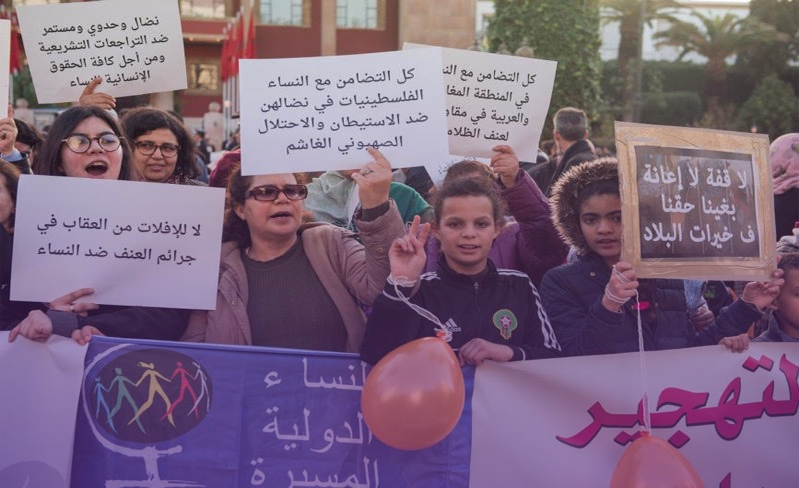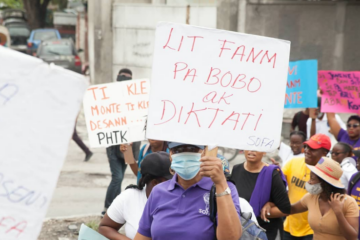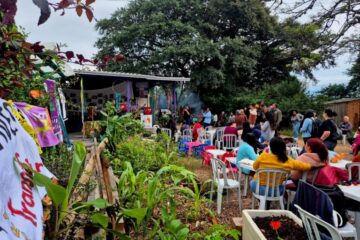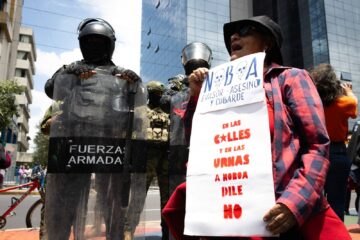This excerpt is part of the article Feminist Movement in Morocco: Trajectory and Perspectives (Movimiento feminista en Marruecos: recorrido y perspectivas), written by Khadija Ryadi as a contribution to the publication Islamophobia and Gender (Islamofobia y Género), available in digital format in Spanish, Euskara, and Galician. The book was published by SOS Racism (SOS Racismo), a federation of autonomous organizations that fight racism and xenophobia in the Spanish state. The publication is part of a process of education and reflection between Muslim and non-Muslim women, gathering articles about the relations between feminism and anti-racism and the challenges posed to face Islamophobia.
The excerpt below provides an outlook of the feminist movement in Morocco from its onset to nowadays and proposes an analysis of paths taken. Khadija Ryadi is a militant in the World March of Women in Morocco. A former president of the Moroccan Association for Human Rights (Association Marocaine des Droits Humains—AMDH), she was awarded the UN Human Rights Prize in 2013.
*
Moroccan women have organized relatively early to defend women’s rights, if we take into consideration the awakening of Moroccan men and women to other matters related to democracy and modernity. (…) Moroccan feminism took its first steps in the 1940s, when the then most important political parties became interested in women’s situation. (…) Women had organized in an association called Akhawat Assafa, which means “the purity sisters.” In 1944, they submitted a number of demands to improve life conditions of women, who were illiterate and poor in their majority. (…) Akhawat Assafa’s cause revolved around respecting domestic workers, demanding a family law that did not exist back then to protect women within marriage, and raising awareness about violence against women…
The Communist Party (CP)—which was in fact a subdivision of the French Communist Party, since Morocco was still under French colonization—had created the Moroccan Women’s Union. The CP was more interested in women’s social and economic issues. Its work was, above else, an attempt to get women from the working class together through the association “Moroccan Women”, which several decades later would become the Democratic Association of Moroccan Women, still active today. This association ended up detaching from the Communist Party, which was banned by the Moroccan regime after the independence and then returned to politics with a program much more oriented by social democracy.
(…) The first wave of Moroccan feminism happened during the time when Morocco was colonized, from the mid-1940s to the beginning of the 1960s.
When this feminist experience connected to political parties was losing its momentum, women unionists took charge of the struggle with the creation, in 1960, of the first women’s independent organization. The Progressive Union of Moroccan Women has its origins in the first Moroccan union central, the UMT, established as an underground organization five years earlier to escape repression from French authorities, which prohibited Moroccan people from creating their own unions. So women were present in all those hard times, both in the national struggle for freedom and in the social struggle inside unions.
After these major feminist political and union experiences, women’s struggles became dormant for a long time. The issue of women’s rights was demoted to the background while the political struggle dominated, particularly after the first confrontations between the left-wing sectors of the national movement and the monarchy over the nature of governance that should be put in practice after independence. This was how repression against the opposition began. (…) Only in the mid-1980s the second generation of feminism started. That decade was a time of awakening for the movement. Militant women from left-wing parties, essentially Marxist women, decided to take over their own destinies. So they started to create women’s organizations outside political parties.
Dawn of a New Feminism
Several factors have contributed to the emergence of a new generation of women’s movements in Morocco.
The most decisive reasons were Moroccan women’s life conditions, as they remained affected by marginalization and discrimination across all levels. The failure of Moroccan laws, with its huge gaps that undermined women’s rights and dignity, was also decisive, including the Family Code then in force, the Criminal Code—still in force—, and the laws governing trade, nationality, the Code of Civil Procedure… and others that continue to be discriminatory. (…)
Other factors—this time external—contributed to the rise of the second wave of Moroccan feminism, the most important of which was the influence of reformist men and women thinkers from Arab countries such as Tunisia and Egypt. (…) Moroccan feminists also amplified the voices of great Eastern writers, such as Nawal Saadawi, Fahima Charafeddine, Farida Nakkache, etc., whose publications helped to create the intellectual basis for Moroccan feminism. Another factor was the impact of different types of feminism from Europe and Western countries in general, particularly after May 1968 in France. The impact of this feminism was deep, as it marked Moroccan feminism and influenced its universalist positioning and work methods.
The New Wave of Feminism Went Through Several Phases
The revival of women’s movement in Morocco was marked by its intellectual aspect. Culture is in the foundations of the current Moroccan feminism. This choice was motivated by the will of establishing legitimacy for women’s demands in a deeply misogynist society and amid a radical political movement that still considered the gender-focused approach a factor that disturbs class struggle.
(…) Women’s cause activists are mainly from left-wing political parties. These parties, dominated by their ideology of class, did not pay enough attention to women’s matters, so many women activists decided to do this by themselves. One of the best known benchmarks of this phase is the creation of the March 8 newspaper, the first newspaper specialized in women’s matters published in Morocco, in which several women writers were involved. The first battlefield was family law.
During the second phase of women’s movement-building in Morocco, the first action frameworks arose, assuming different forms. Such is the case of women’s committees at universities, created by activists from the National Union of Students of Morocco. (…) The second framework was the women’s associations created in youth centers. (…) In every corner of the country, many associations concentrated on women’s literacy efforts, which allowed reaching out to women from underprivileged classes, also creating associations dedicated to women workers inside unions.
The creation of the Moroccan Association for Human Rights in 1979, the largest association for human rights in Morocco, and the development of the UN Convention on the Elimination of All Forms of Discrimination Against Women (CEDAW) influenced women’s movements and the choice of a universal reference for the basis of their struggles and demands. It formed the third phase of Moroccan women’s movement.
(…) Most women’s associations created back then and that are currently at the core of what is usually called Moroccan feminist associations (…) considered that women’s struggles should essentially be focused on challenging patriarchy as the origin of women’s oppression. A minority of women activists remained loyal to their analysis and chose to take action in unions with women, connecting the struggle against gender-based violence to other forms of patriarchal oppression.
The Phase of Demands
The year 1993 was special for Moroccan women’s movement. For the first time, different women’s frameworks, mainly the feminine sectors of opposition parties, women’s committees of unions, and some recently-created women’s rights associations, gathered in a network and announced the beginning of a struggle to change the Code of Personal Status. This battle played an important role in society and, for four months, was the center of struggles in the country. (…) The year 2000 was the second important year in the timeline of women’s movement in Morocco, since the first march of women for women happened that year, gathering dozens of thousands of women—however, a concurrent march, organized by conservative parties and movements, was much bigger and more impressive. The battle was lost again, but women did not give up.
A new alliance of women called “The Equality Spring” was created, once more struggling for a new family code. The battle had partial outcomes in 2004, when the law was amended and replaced with a new one, much fairer, but which fell short of women’s expectations regarding equality and citizenship. This phase allowed women’s movement to establish in society as agents of struggle and change. It also allowed it to occupy the center of the political scenario for a long time. (…)
Mistakes in the Moroccan Women’s Movement
(…) Concern with women’s independence of political parties has ultimately become a phobia about politics, particularly about the left wing, which is the origin of the movement’s founders.
This has caused the movement to become not so sensitive to movements for change in society as a whole. (…) However, most social movements that arose and the grassroots demonstrations that emerged throughout the country over the last fifteen years are, in their majority, women’s movements, or at least marked by a significant participation of women. Moroccan feminism withdrew from women’s struggles against other forms of oppression and discrimination, such as class oppression or discrimination against rural women.
Such situation was reinforced at the beginning of the new millennium. In fact, after the terrorist attacks in Morocco in 2003, the Moroccan government (…) declared itself a defender of freedoms and the only alternative to the Islamist project. Women’s associations are the most sensitive to this discourse, since women are Islamists’ favorite target. Such alignment has affected the image of women’s association, which became more visible in 2011, when, in the wake of the grassroots demonstrations in the so-called Arab world, demonstrations of a youth movement called February 20 Movement burst in dozens of Moroccan cities. Hundreds of thousands of demonstrators and more than 100 left-wing organizations and unions and political parties formed a network to support the movement, except for women’s organizations, which abstained. Their justification was that Islamists were members of organizations participating in the demonstrations. It was a historic moment, and women’s movement positioning was not interpreted in a positive way.
Perspectives for a Militant Women’s Movement
The mentioned decisions taken by women’s associations are not expected to be reviewed. (…) This renewal is expected from women’s local organizations. Although they are less known, they are more numerous and more effective. They will be successful in this mission because they are more committed to working together with grassroots movements due to geographical location, to a sense of class belonging, or to ideological choices. They are in a better position to reinvent the Moroccan feminism. To build feminism in their territory, but not as a form of assistance. A new way of citizen mobilization to change women’s situation. An action strategy with women and not for women. A type of feminism that finds its place in harmony with the struggles for a more equal society. Because feminism that struggles against sexism and gender inequality cannot be apart from the struggle against other forms of exploitation and discrimination, and will be successful only if it is capable of integrating with the several struggles for emancipation of the entire Moroccan people.
(…) Houria Bouteldja defends a feminism that doesn’t have to choose between being anti-sexist or anti-racist. A feminism she describes as “paradoxical,” which has to protect “Arab women” from the real sexism they face in their communities (and also in the European society), while also defending “Arab men” from the racism that accuses them of being sexists by nature. A feminism that may also be defended by feminists who do not directly suffer structural racism, but who remain open to deconstruction of our (neo)colonial knowledge and practices; women who don’t want to omit “race” neither require or believe that resistance strategies must always and only be based on gender.




